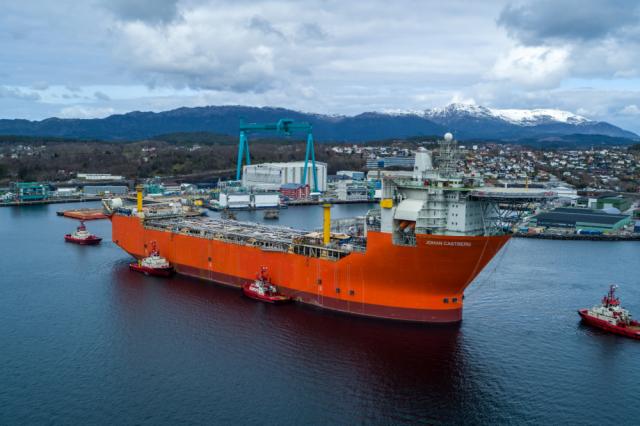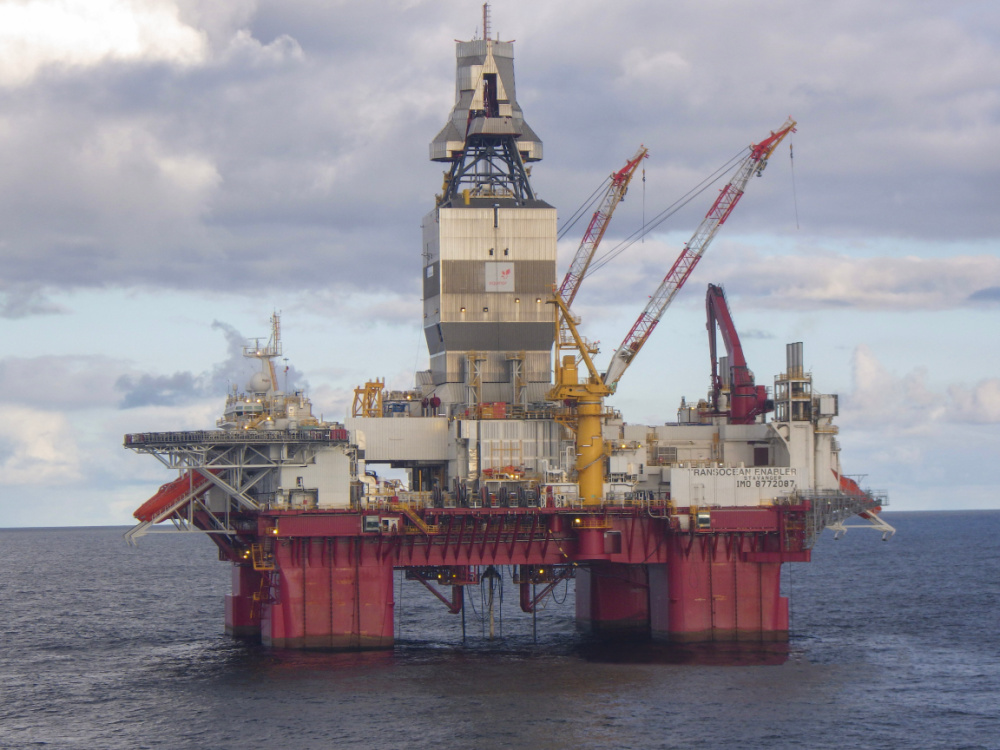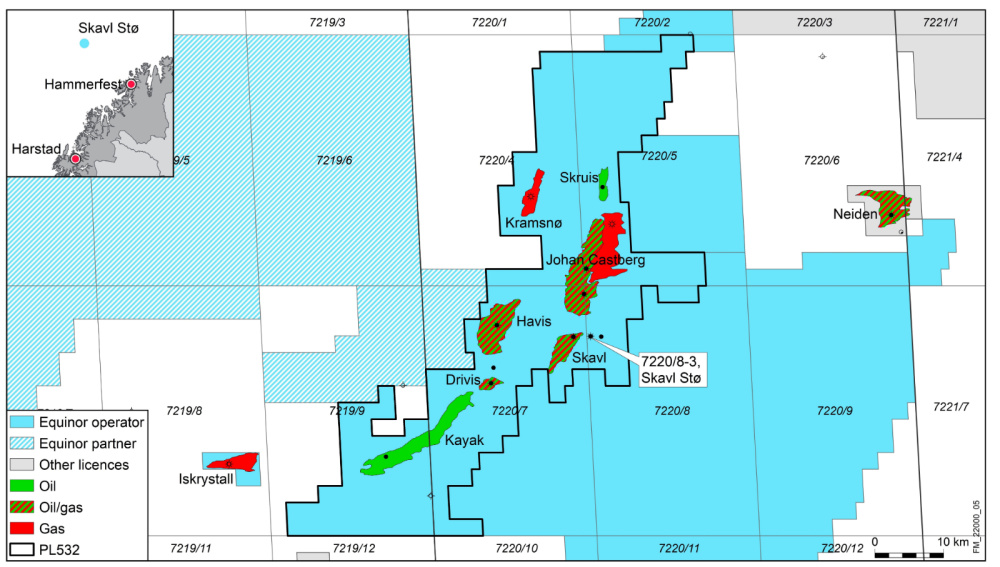
The Johan Castberg FPSO arriving at Aker Solutions Stord in April 2022. (Source: Jan Arne Wold & Roar Lindefjeld / © Equinor)
Equinor ASA and its partners are considering tying back two recent Barents Sea discoveries to the Johan Castberg production unit.
The field development concept brings production from a number of subsea wells to the Johan Castberg FPSO. While the field was originally discovered in 2011, Equinor had to re-think the design plans and subsequently didn’t submit a plan of development and operation to Norwegian officials until 2017. Several more discoveries have been made in the production license since.
Equinor announced the Skavl Stø oil and gas discovery on June 9 and the Snøfonn North discovery the previous month.
The Transocean Enabler drilled the Skavl Stø well on the Johan Castberg Field. Skavl Stø is the 13th exploration well in the Castberg license.

Equinor estimates the latest discovery in production license 532 at between 5 MMboe and 10 MMboe. Estimates at the Snøfonn North discovery are between 37 million and 50 million barrels.
“The [Skavl Stø] discovery and information will be viewed in the light of other discoveries in the area, and together with our partners we will consider further development of the area,” Kristin Westvik, Equinor senior vice president for exploration and production north, said in a news release.
Milestone Fact Box |
|
| 2009 | License awarded |
| 2011 | Skrugard discovery |
| 2012 | Havis discovery |
| 2014 | Drivis discovery |
| 2014 | Skavl discovery |
| June 2018 | Norwegian Parliament approves Johan Castberg plan for development and operation |
| 2021 | Isflak discovery |
| April 2022 | Johan Castberg FPSO arrives in Norway |
| May 2022 | Snøfonn Nord discovery |
| June 2022 | Skavl Stø discovery |
| 2024 | Johan Castberg slated to begin production |
Westvik said the Snøfonn North discovery—which was the 10th discovery and the 12th exploration well to be drilled in PL 532—could “add valuable volumes to the installation in the future.”
In March 2019, Equinor said the Isflak exploration well in the license held an estimated 31 million to 50 million barrels of recoverable oil. The well was permanently plugged and abandoned.
In October 2018, Equinor announced the Skruis exploration well had a confirmed recoverable volume of 12 million to 25 million barrels. At the time of that discovery, Equinor said it would consider tying the find into the FPSO after full capacity tapered off.
“Through the Johan Castberg field development we open a new oil province in the Barents Sea, enabling us to tie in this type of small discoveries that will be highly attractive when the infrastructure is in place,” Knut Gjertsen, project director for the Johan Castberg development, said at the time.

The field’s recoverable volumes are estimated at between 450 MMboe and 650 MMboe.
When Equinor submitted its PDO for Johan Castberg, it said the project was “the biggest offshore oil and gas development to be given the go-ahead in 2017.”
The development journey has presented some challenges.
In 2017, Margareth Øvrum, Statoil’s executive vice president for Technology, Projects and Drilling, said the project as originally envisioned was not commercially viable “due to high capital expenditures of more than NOK 100 billion and a break-even oil price of more than USD 80 per barrel.”
The NOK 49 billion budget for the revised plan featuring the FPSO and subsea wells will be profitable at oil prices of less than $35/bbl, Øvrum said.
In April, the Johan Castberg FPSO arrived in Norway, where it anchored at Aker Solutions’ quay on Stord. There, the turret and process modules will be installed during the spring and summer. Following connection, everything will be commissioned and tested.
The Johan Castberg FPSO is designed for 190,000 bbl/d of production and a life of 30 years. Kværner had the contract for the topsides, while Sembcorp Marine delivered the hull. SBM Offshore won the mooring contract.
The FPSO will serve 18 production and 12 injection wells. The 30 subsea wells will be distributed on 10 templates and two satellite structures. Aker Solutions won the subsea templates contract.
Production License 532 At-a-glance |
|
| Location: | Barents Sea blocks 7219/9 and 7220/4,5,7 |
| Water depth: | 360-390 m |
| Estimated cost: | NOK 49 billion |
| Production unit: | Johan Casterberg FPSO |
| Capacity: | 190,000 bbl/d |
| Design life: | 30 years |
| Field plan: | 18 horizontal production wells and 12 injection wells on 10 templates and 2 satellite structures |
| Recoverable volumes: | Estimated at 450 mmboe-650 mmboe |
| Reservoir: | Deposits from Late Triassic to Middle Jurassic age in the Tubåen, Nordmela and Stø Formations at depths of 1,350 to 1,900 m |
| Operator: | Equinor (50%) |
| Partners: | Vår Energi (30%) and Petoro (20%) |
Equinor will use permanent reservoir monitoring to improve recovery from the field. Alcatel Submarine Networks won the permanent reservoir monitoring contract and Nexans Norway AS was tapped to deliver more than 200 km of subsea cable. More than 3,700 sensors on the seabed will provide information about the reservoir before and during production, according to Equinor.
At the time, Benedicte Nordang, subsea manager for Johan Castberg, said the information will increase the well placement precision and help control production and injection.
Recommended Reading
Patterson-UTI Braces for Activity ‘Pause’ After E&P Consolidations
2024-02-19 - Patterson-UTI saw net income rebound from 2022 and CEO Andy Hendricks says the company is well positioned following a wave of E&P consolidations that may slow activity.
Petrie Partners: A Small Wonder
2024-02-01 - Petrie Partners may not be the biggest or flashiest investment bank on the block, but after over two decades, its executives have been around the block more than most.
CEO: Coterra ‘Deeply Curious’ on M&A Amid E&P Consolidation Wave
2024-02-26 - Coterra Energy has yet to get in on the large-scale M&A wave sweeping across the Lower 48—but CEO Tom Jorden said Coterra is keeping an eye on acquisition opportunities.
SilverBow Rejects Kimmeridge’s Latest Offer, ‘Sets the Record Straight’
2024-03-28 - In a letter to SilverBow shareholders, the E&P said Kimmeridge’s offer “substantially undervalues SilverBow” and that Kimmeridge’s own South Texas gas asset values are “overstated.”
Hess Corp. Boosts Bakken Output, Drilling Ahead of Chevron Merger
2024-01-31 - Hess Corp. increased its drilling activity and output from the Bakken play of North Dakota during the fourth quarter, the E&P reported in its latest earnings.






